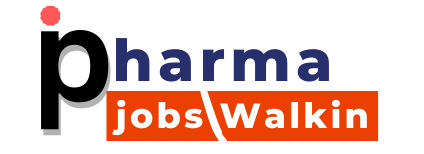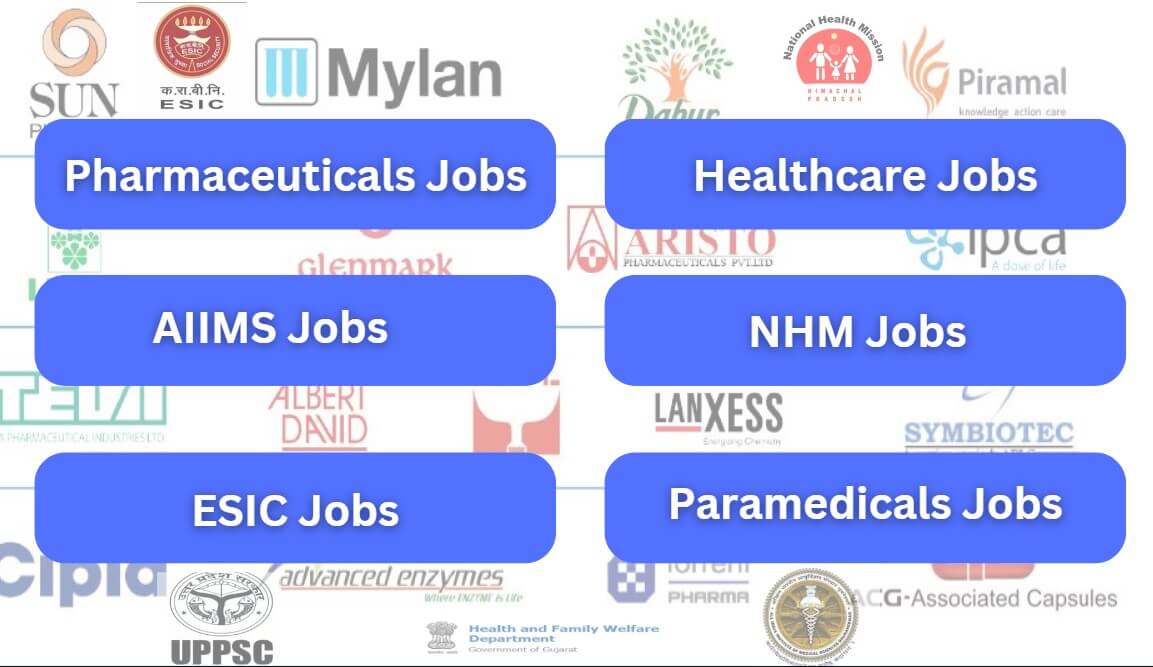Find all the latest pharma jobs, pharma walk-in interviews for freshers and experienced Candidates, healthcare jobs, government, and Jobs for Lifescience Candidates. Please get the Latest Pharma Job alert notifications from Top pharmaceutical companies by Joining our Telegram Channel.
Pharma Walk-in-Interview (MAY 2025)
- Immacule Lifesciences – Career Opportunities in Pharmaceuticals (QC, QC Microbiology & More)
- Gracure Pharma Bhiwadi Jobs 2024: Apply for Various Departments
- Amneal Pharma Walk-In Interviews on 15th September 2024
- Unichem Laboratories Walk-In Interview from 9th September to 14th September 2024
- Torrent Pharmaceuticals Walk-In Interviews on 15th September 2024
- Dr. Reddys Walk-In Interview On 8th September 2024
- Macro Polymers Job Vacancy For Emulsion Production Department
- Advantmed Walk-In Interview For Fresher as Medical Coder
- Cadila Pharma Walk-In Interview on 01 September 2024
- Zydus Life Sciences Recruitment Drive on 31st August 2024
- Bharat Parenterals Walk-In Interviews on 31st August 2024, 1st September 2024, and 2nd September 2024
- Lupin Limited Walk-In Interview @indore on 01st September 2024
- Emcure Pharma Walk-Ins Interview @Ankleshwar on 1st Sep 2024 (Sunday)
- Hetero Walk-in interview at Hyderabad on August 31, 2024
- Aculife Healthcare Walk-In Interview For B.Sc/ M.Sc/ B. Pharm or M. Pharm on August 31, 2024
- Natco Pharma Walk-In Interview for Production (Sterile), Engineering, QC & Microbiology on 1st September 2024
- Torrent Pharma Pithampur Walk-In Interviews: August 31, 2024
- Cipla Limited Walk-In Interview for @Goa On 1st September 2024
- Alembic Pharma Walk-In Interviews for Production/Packing/QA/QC
- Intas Pharmaceuticals Walk-In interview for Various Department on 1st September 2024
Pharma API Jobs (MAY 2025)
- Unichem Laboratories Walk-In Interview from 9th September to 14th September 2024
- Harman Finochem Walk-In Interviews on 08 Sep 2024
- Zydus Life Sciences Recruitment Drive on 31st August 2024
- Piramal Pharma Solutions Walk-In Drive On 1st September 2024- Check Details Below
- Mankind API Jobs for Quality Control and Quality Assurance Positions
- Biocon API Jobs: Walk-In for Fresh Graduates
- Alembic Pharma Walk-In Interviews for Production/Packing/QA/QC
- MSN Laboratories Walk-In Drive For API Production on 24th August 2024
- Sri Krishna Pharmaceuticals Walk-In Interview on 24th August 2024
- Global Calcium Walk-in Drive Hosur on 03 Aug 2024
- Aragen Lifescience Walk-In Interview on 3rd August 2024
- Hetero Walk-In Interview API for QA/QC on 27th July 2024 @Hyderabad
- Fermenta Biotech Walk-In Interview For Production- Apply Now
- SMS Pharmaceuticals Walk-In On 26th, 27th & 28th July 2024
- SRF Limited Walk-In Interviews to Hire Sr. Executive on 19th July 2024
Pharma Knowledge
- SOP for Preparation of Aluminum Seals at Vaccine Formulation
- SOP for Vial Washing Machine
- SOP for Rounding off Analytical Results
- SOP for Analytical Method Transfer
- HPSPC Registration, Renewal, Transfer filling process 2023
- 11 International Travel Policy for Private Professionals/ Employees
- Multimill Design Qualifications in Pharma
- Design Qualification of Bin Blender
- Performance Qualifications Of Generation Of Purified Water
- UPPC Apply Online, Registration, Renewal, Fee, Process, and Form
- SOP for Cleaning and Operating a Peristaltic Pump
- SOP for Tub Handling of Pre-filled syringes of filling machine
- SOP for Footwear Cleaning
- SOP for Disintegration Test Apparatus
- SOP for Friability Test Apparatus
Interview Questions
NIPER Jobs
Pharma College Jobs
- Gyan Vihar School of Pharmacy Recruitment for Principal and Pharma Faculty Recruitment
- Bhagwati College of Pharmacy Recruitment for Assistant Professor
- NIPER Hajipur Faculty Recruitment 2024 Application PDF and Apply Online
- Pratiksha Institute of Pharmaceutical Sciences Recruitment for Professor and Admission Officer, Apply Now
- Sardar Patel College Pharmacy Faculty Recruitment
- Oxbridge College of Pharmacy Recruitment for Assistant and Associate Professors
- Roorkee College of Pharmacy Faculty Recruitment (22 Post) Apply Directly
- CUG Recruitment 2023: New Notification for Pharmacists, Apply Now
- Pharma Faculty Recruitment at Dr. Bhagat Singh Rai College of Pharmacy
- Professor, Associate Professor & HOD jobs at Gitanjali College of Pharmacy
Pharmacy MCQs
- HPSPC Continue Pharmacy Education Programme (CPE) Next Date 2023
- B Pharmacy Syllabus: PCI subjects, Semester Wise, 1 Year syllabus 2023
- 250 Pharmacology and Toxicology MCQs with Answers pdf
- 500+ MCQs on Pharmacology (Most important) in 2024
- 65 Top Pharmaceutics MCQs Questions with Answers pdf
- 131 Top Industrial Pharmacy MCQs with Answer
Company Wise Pharma jobs
| Aurobindo | Concord Biotech | Jubilant | Panacea |
| Alkem | Dabur India | Kusum Healthcare | Park |
| Abbott | Divis | KAPL | Pfizer |
| Aishwarya Healthcare | Dr. Reddy | Kekule | PI Industries |
| Arti Industries | Encube Ethicals | Lincoln | Psychotropics India Ltd |
| APL Healthcare | Energon Labs | Lupin | Pulse |
| Alembic | Emcure | Lee Pharma | Rubicon Research |
| Allkind | Eris Lifesciences | Laborate | Reckitt Benckiser |
| AstraZeneca | FDC | Marksans | Rusan Pharma |
| Avantika | Finecure | Mankind | Rakshit Pharmaceuticals |
| Aizant | Granules India | Medley | Strides |
| Amneal | Gland Pharma | Merck | Selmar |
| Annora | Gsk | Macleodes | SMS |
| Arene Lifesciences | Glenmark | Micro | Steril-Gene |
| Aragen | Gracure | Morepen | Sanofi |
| Apex | Hetero | MSN | Sri Krishna |
| Apitoria | HLL Lifecare | Mylan | Sun Pharma |
| Biological E. Limited | Hy-Gro Chemicals | Neuland | SRF Limited |
| Biocon | Honour | Natco | Saga Lifesceience |
| Biophore | Ind-Swift | Nector | Synokem |
| Bharat Biotech | Indoco Remedies | Novartis | Torrent |
| BioMatrix | Intas | Novo Nordisk | Teva |
| Bharat Parenterals | IPCA | Optimus Drugs | Tagoor Lab |
| Corona Remedies | Immacule Lifesciences | Otsuka | Unison |
| Cipla | Johnson & Johnson | Piramal | USV |
| Unichem | Vimita Lab | Wyeth | Zydus Cadila (GR) |
| Vital Therapeutics | Wockhardt | Windlas Biotech | Zee Laboratory |
| Virchow Biotech | Wings Biotech | Zydus Cadila | — |
Pharmaceutical Jobs: To provide information about pharma job alerts and Pharma walk-in interview
The future is unpredictable, but we help you safeguard your future. It provides helpful information and support from industries.
Did you know that both rural and urban India saw an employment loss of about 1.5 million people in August 2021-22? Yes, the COVID-19 pandemic has had a serious impact on the labor economy. Both small enterprises and multinational corporations have had to reevaluate their personnel needs.
Are you an Indian citizen who is unemployed as a result of the epidemic and the unstable employment market?
Are you pondering your next move while employed by a multinational corporation that is undergoing restructuring?
Pharmaceutical Jobs for College Students
Are you just out of college and looking for your first Pharma job in India? Do you doubt your suitability for a position in the pharma industry?
You’ve arrived at the proper location. We provide you with all the latest information about pharma job vacancies near you.
Pharma jobs for freshers
For Fresher candidates, it becomes impossible to find a job in pharmaceuticals. because the pharmaceutical company always approaches to find experienced and suitable candidates. but companies still conduct pharma jobs for freshers from time to time. it may be for B.Pharma, M.pharma, and any discipline. companies hire fresher candidates based on their interest and capability to do work.
Pharma jobs freshers update
On This website, you will get the all information related to pharmaceutical jobs for freshers as well as for experienced candidates. So stay tuned here, to get this type of information.
Why Should I Consider a Pharmaceutical Job?
Everyone who from B. Pharm, M.pharm, and science Background is looking to get a Job in a pharmaceutical company. If you are searching Pharma Vacancy By Location. If you looking for a Pharmaceutical Jobs walk-in Interview in 2024, here get the latest and weekly pharma walk-in updates with all required details at the time of the interview.
Additionally, Private employment in India may be rather lucrative with respectable pay, benefits, and pensions. The Regulatory Job In Pharma, The RA post like an executive position is one of the highest-paid positions in Pharmaceuticals. Remember that there is a difficult interview process and significant competition for these positions!
What Kind of vacancy in a pharma company Can I Get?
We at Pharma jobs walk-in Provide you with all kinds of vacancies in the Pharma industries. get the Latest Regulatory, Production, QC, Store, Engineering, Micro, R&D, and QA Jobs. You will also get the Latest Govt. pharma Jobs for Pharma Students and Pharma Professionals, Also find Govt. Pharmacist Exam Result.
Way To Get Pharma Jobs In Pharmaceutical Industries?
In the face of enormous competition, it’s challenging to stand out. However, by taking these four steps and having the appropriate tools at your disposal, obtaining that Indian Pharmaceutical job won’t just remain a pipe dream. Research the job specifications at Pharma-jobs walk-in in step one.
Requirement for Pharmaceuticals jobs in India
Knowing what position you are applying for is the first step to gaining a job in the Indian industry. You must fulfill several eligibility conditions, remember crucial deadlines, and the interview process, and pass the exam to work for the Indian Pharmaceutical industry.
What is the Salary Range in Pharma?
The Salary in Pharmaceuticals depends on the Area of work, working experience, and Performance. if talk about the highest pharma salary jobs in India. Here is the
List of Highest paying pharma jobs from Highest to Lowest:
Research scientists >>Medical Transcription>> Medical Representative>> Regulatory officer >>Formulation Development >>Quality control >>Quality Assurance >>Production >>Microbiologist
Demands of Pharmaceutical Jobs 2024 :
For several decades, India has seen significant demand for pharma industry jobs. People choose pharmaceutical industry careers over other types because of the numerous advantages that come with them. Millions of Americans, Indians, and others dream of finding a “pharmaceutical company job,” but only a select handful are fortunate enough to do it. People frequently take satisfaction in holding government or pharma govt jobs.
Best Pharma Working Location 2024
Baddi, Haridwar, Bhiwadi, Hyderabad, and Sikkim are the major areas where small, Medium, and MNC pharmaceuticals are engaged in the manufacturing of life-saving medicines. Major Pharma companies doing a walk-in drive for the recruitment of pharma professionals for different positions. At the Pharma Job portal, you will get all these kinds of pharma job alerts at the right time.
Pharma Vacancy FAQs
1. Who we are?
Answer: At Our portal, you will get information on recent Pharmaceutical jobs, walk-in jobs, and Pharma jobs alert notifications by telegram channel.
2. How do We Find Job notifications on Pharma jobs walk-ins?
Answer: Visit Our Website regularly we update Pharma vacancy Notifications daily
3. Is Pharma jobs walk-in Updated Daily?
Answer: Yes, We Updated jobs in Pharma and Govt, Jobs On a Daily and weekly Basis And it also gives the Latest Sarkari Job updates.
4. Why Pharmajobswalk-in is better for the Latest Jobs info?
Answer: At our jobs portal, you will get the Notification related to your field as soon as possible.
5. Which pharma job has the highest salary?
Answer: Research scientists, Medical Transcription, Medical representatives, Regulatory officers, Formulation Development, Quality control, Quality Assurance, Production, and microbiologists.
6. Which pharma company is best to work for?
Answers: Pfizer, Cipla, Glenmark, Novartis, and Alembic Pharma.
7. Are pharmaceutical jobs good?
Answer: The pharmaceutical industry provides the best opportunity to work and chances of high career growth. Pharmaceuticals also help to grow in skill as well as career path.

